2020 Update – Originally Published March, 2016
Surface water runoff from rain, downspouts, roofs and gutters can make your life miserable if your landscape grading hasn’t been properly designed.
The equation isn’t terribly complicated: water needs to flow away from things it can damage. But this can sometimes be overlooked or frankly creep up on you if you’re making several changes during an outdoor construction project.
And it was that “creeping up on you” scenario that caught me totally by surprise, resulting in a sobering realization coupled with some painful, costly and time-consuming additional construction work!
A Saga of Runoff & Landscape Grading Pain
We don’t take many vacations as a family – the logistics are hard for us. So, a few years ago, we decided we would take our vacation money and slowly create the most “awesome backyard ever” for everyone to enjoy. It took almost 3 years to complete, one piece at a time.
We wanted a pool, a patio sitting area (far enough from the pool to have a fire pit), beautiful landscaping and lush grass. Naturally, with goals like these, we knew there would be surprises – unexpected additions and expenses.
And there surely were…
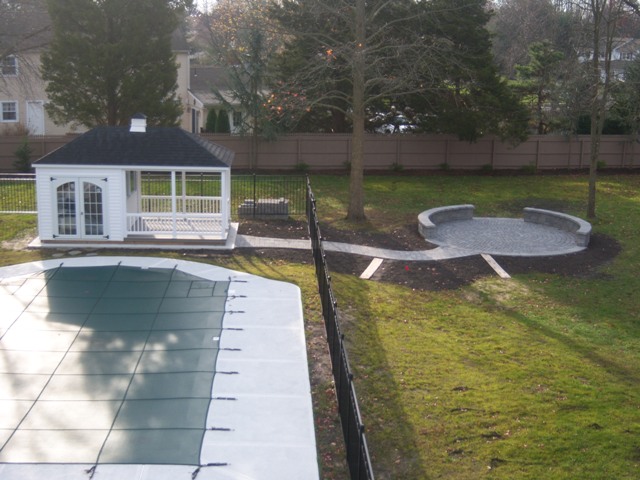
One surprise addition came in the form of a slightly customized shed we put up by the top of the pool. We added railings, a cupula on the roof – and glass front doors so it looked really nice. So nice that we call it our “cabana” now. We keep pool stuff in there, and people can even change if they need to, as long as they don’t stand too close to those glass doors!
With an improvement like this, there’s more money to spend, of course – but you’re getting something for it: something you can see, something you can appreciate – and something you cannot easily add later.
Oh, and in case you’re not sure what a ‘cupula’ is (as I never heard that word before this project), it’s one of these cool-looking rooftop things…
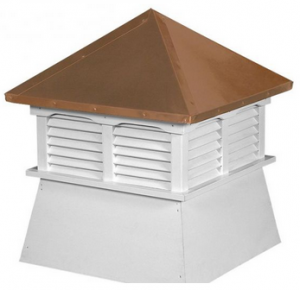
We’re very happy with our little cupula. On top of our tricked out shed!
Regarding runoff, though – take a close look at that earlier picture now… the problem may jump right out to you already, but let me break it down into its pieces, each of which clarified (to me) as construction efforts progressed:
The Pool Grading and Rain Runoff
Installation of an in ground pool is a major construction project and always requires grading consideration. In my case, we needed to elevate the pool and surrounding property about 12-14 inches so there was no risk of runoff flowing into the pool. The pool guys knew exactly what they were doing, and in the end we used not only the fill from the excavation to achieve this grading, but a couple of additional dump trucks of dirt as well.
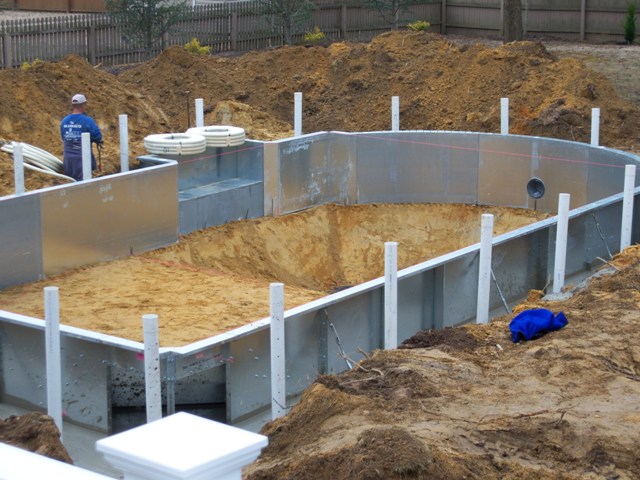
Had we stopped with the pool installation, this would have likely been just fine.
But no… We had more plans brewing.
The Pool Shed Elevation
The cabana was an idea that came to us while the pool was being built, and it was particularly tricky with permits and inspections. It may look really expensive, but it after a bit of research we had an idea… Let’s talk to a local shed company about making a few changes to a storage shed. The owner was willing, and it was *much* cheaper doing this.
(The word “cabana” definitely comes with a much higher price tag than the word “shed!”)
We could have put the structure on top of blue stone or concrete. But we really wanted make things as neat and precise as possible, so we opted for concrete.
And the elevation of this concrete cabana foundation?
Well, this naturally had to be at the same level at the pool concrete. Which means, in essence, that our pool shed was now also about a foot higher than the natural backyard elevation.
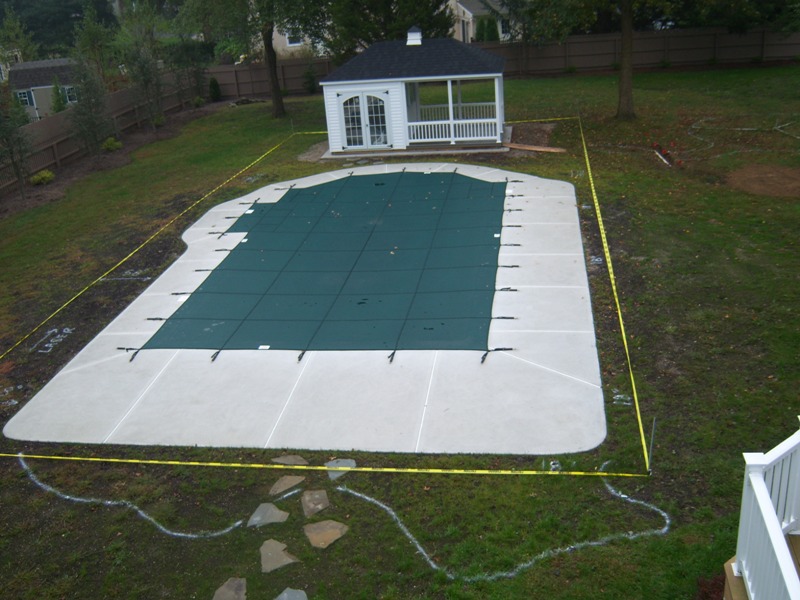
You can start to see it coming now, right?
Hold that thought – it gets worse…
The Paver Patio and Serpentine Walk Runoff
The final piece of the major construction items was an idea my wife had for a circular paver patio, which we both really love. My only addition idea-wise was the serpentine walkway connecting it to the cabana and effectively linking all the hardscape items.
The elevation of these items surely had to be, once again, roughly at the same level at the pool concrete. And now I was really starting to worry. So much so, that I bought and buried a 4 inch PVC pipe about a foot under where the serpentine paver walkway would be. (I had the ground marked out with spray paint for the precise walkway shape and location.)
I was starting to have very clear visions of a dam forming in the yard, and having a pipe underground would at least afford me some options if this ever really came to be.
But, maybe once the patio and walkway are installed – this will work itself out?
Here’s that original picture once more:
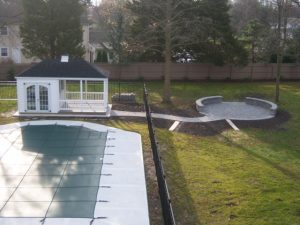
The Resulting Backyard Runoff Dam
So, as I’m looking at all of these items, I’m thinking… “this isn’t good.”
Then, I’m starting to panic a little bit. And then I conveyed this all to my wife, and she says, quite correctly so, that I always consider the worst case scenarios and it will very possibly be just fine.
It wasn’t fine…
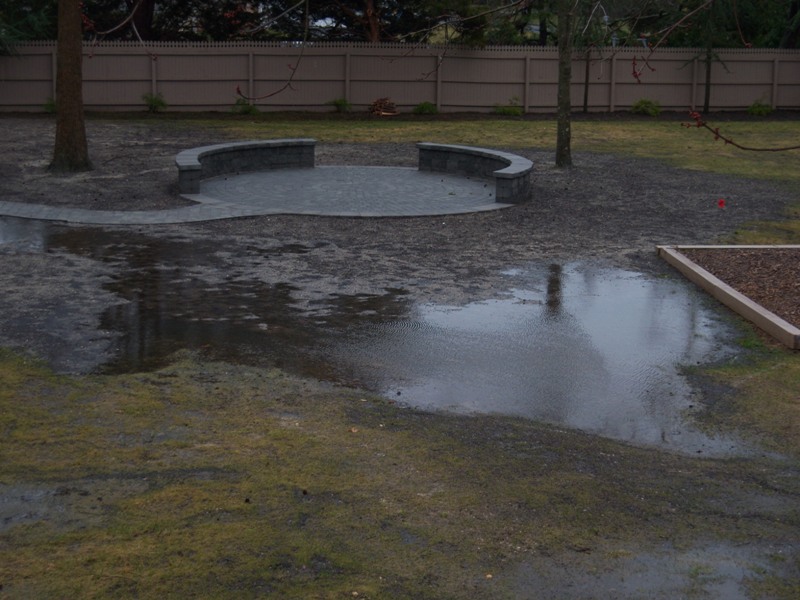
Just lovely, right?
Now, I’m no longer panicking – now I need a drink, because I can see how this is going to have to be corrected.
The fix is going to cost a lot of additional cash, it’s going to require an entire additional construction effort, and unlike the “cabana” (pool shed) – there will ultimately be absolutely nothing to show for it.
Maybe I need two drinks.
Topsoil for Surface Runoff and Absorption
Simply put, I had to elevate a huge chunk of my backyard.
Well, not only “elevate,” but truly re-grade, overall. Massive amounts of topsoil would be required, and consideration to all facets of runoff would need to be considered. In the end, I wanted no standing water. Anywhere.
I came up with a plan which I discussed at length with my local landscaper. There’s a drawing below that you’ll have to expand to see; it’s not very complicated. But my five key design requirements were as follows…
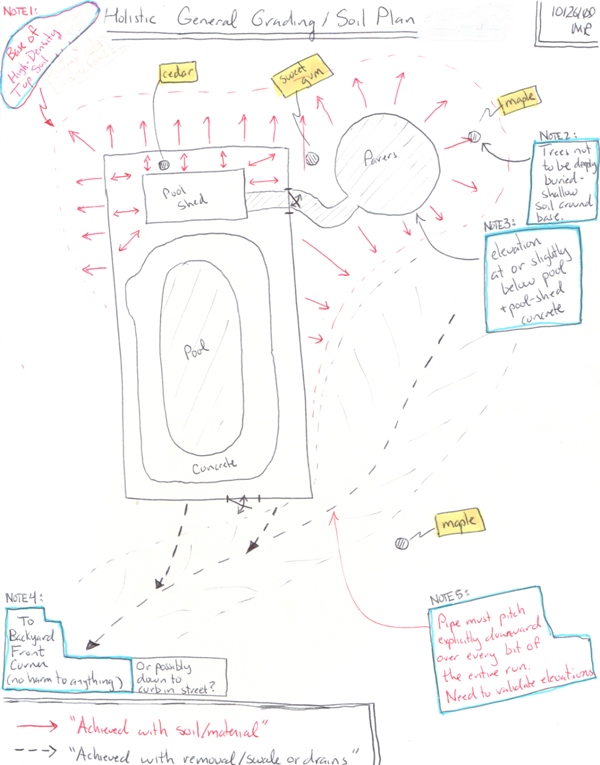
Item 1: Water Runoff must flow away from the house
Item 2: Water runoff must not flow onto neighbors’ properties
I didn’t expect any problem with this since I have a Belgian Block landscape border around the yard – almost a mini retaining wall, really. But it needed to be stated and must always be considered. Most residential neighborhoods are initially graded with swales at the plot perimeters, which guide runoff gently down to the street. These must be maintained.
Item 3: Water must flow away from pool, cabana, patio and walkway
This was the main problem I was facing, of course.
But I had to watch out for my house and my neighbors’ houses first… in part, because I’m the best neighbor ever!
Item 4: Topsoil must be dense, but capable of growing grass
You have to be a little careful here. If you buy or acquire “clean fill,” you really don’t know what you might get, and if you end up with something with the quality of beach sand, growing a lawn could be a problem. On the flip side, buying organic topsoil isn’t necessarily ideal either as it will contain manure and/or mulch, and while these are great for lawns and gardens – your grading will compact over time as the organic material decomposes.
I went with true topsoil, but made it really clear that we *must* avoid the organic variety. This was the only item that was slightly good for my wallet, as the organic topsoil was the most expensive.
Item 5: Minimal topsoil around bases of mature trees
Re-grading can be risky to existing trees if the roots are buried too deeply. Some of the mature trees in my backyard are 50-60 feet tall, and I didn’t want them to slowly die over a few years from being, essentially, buried alive. Different trees have different tolerances, of course… But the main point was simply to disturb as little as possible near the focal maples, cedars and oak trees. Note the call-outs to the trees in my drawing above.
The Landscape Grading Transformation
I lost count. I can only estimate that we used about 20-25 dump trucks filled with top soil. It was non-stop over several days, and the removable fence section I built into my cedar fencing was imperative for all of this.
(If you’ve ever considered adding a removable fence section, it’s an absolute must-have in my experience. Scan the article at the link in the previous sentence if you want to see what this is and how you can build one for yourself.)
The resulting transformation is shown in the images that follow…
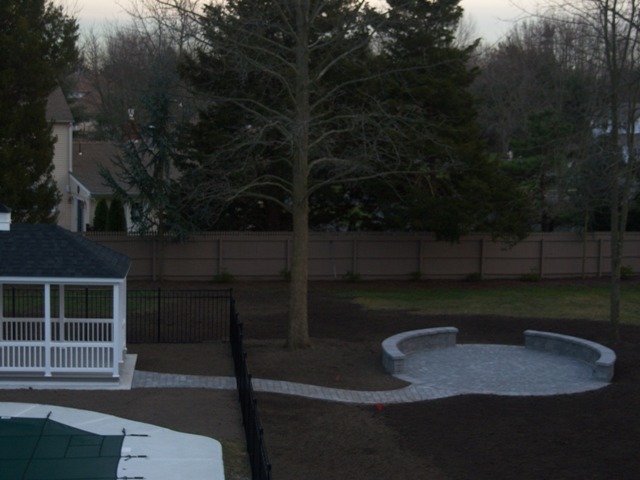
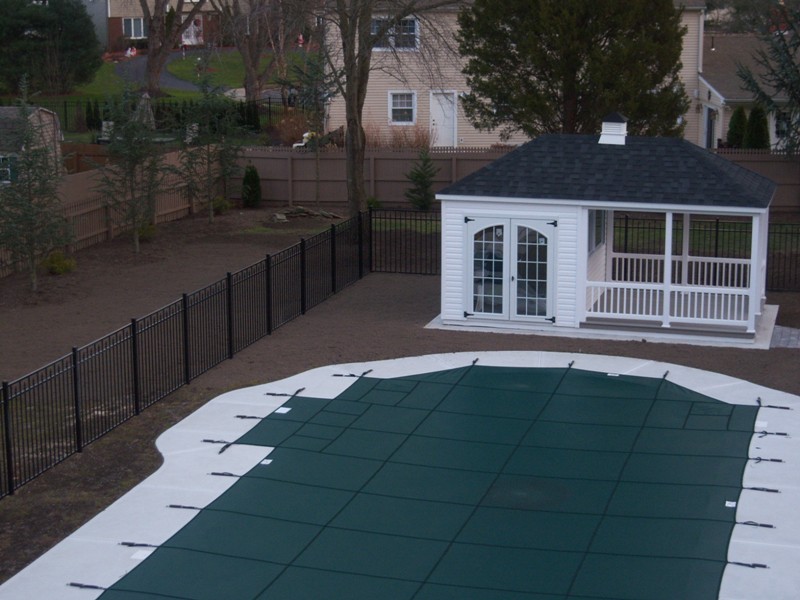
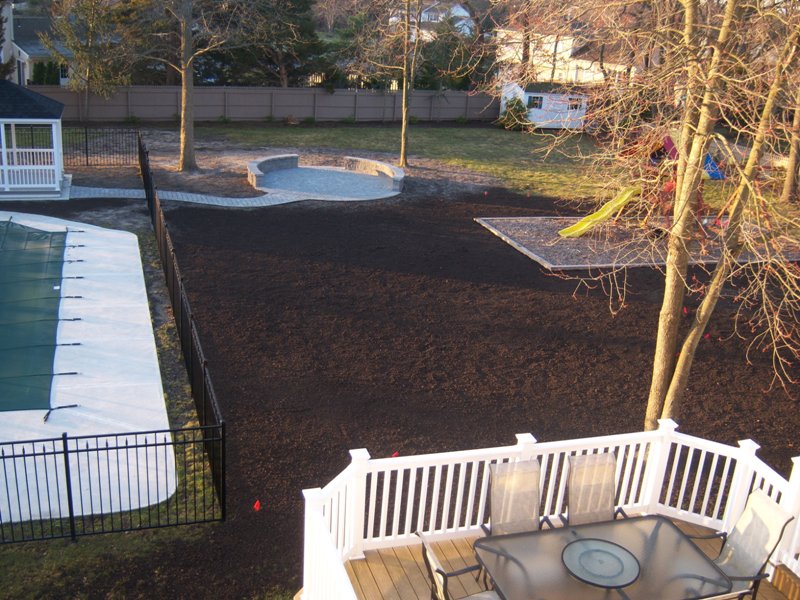
The Final Outcome: Lakes in my Yard?
The real question upon completion of all this was, of course, will this really work? Once we have grass and there are three days of rain, will the new grading and topsoil be able to divert water away from the hardscape areas while allowing for dispersion and absorption into the soil, instead of the ponding that had formed my earlier backyard lake?
Short answer: Yes, it worked.
But I knew all along there was a risk it wouldn’t, and this was part of the reason this was such a painful effort. Lots of work, lots of money, nothing to show for it in the end (more dirt under my grass)… And it might not even work.
But it did. Thank goodness.
The following shots were taken three years after all the major construction illustrated above, with a decent lawn and plenty of time for the topsoil areas to have settled. No ponding at all.
In fact, the pool landscaping has really been thriving…
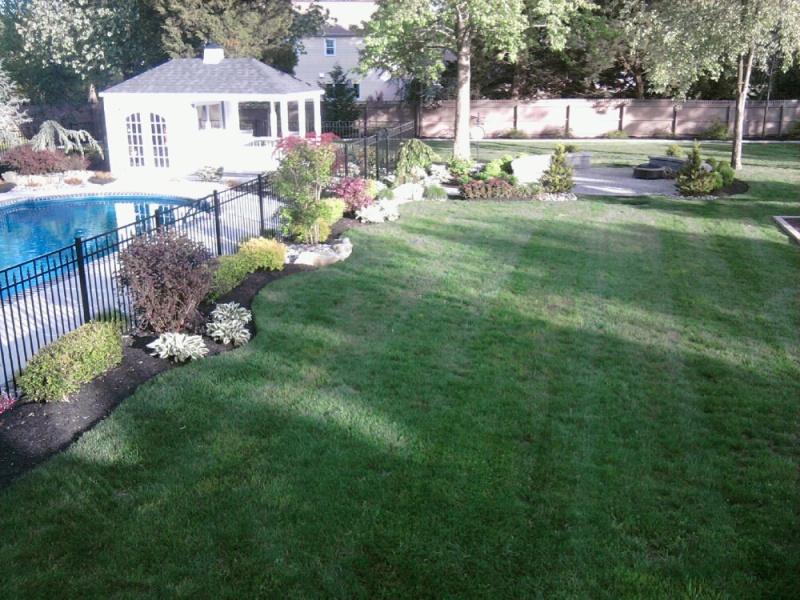
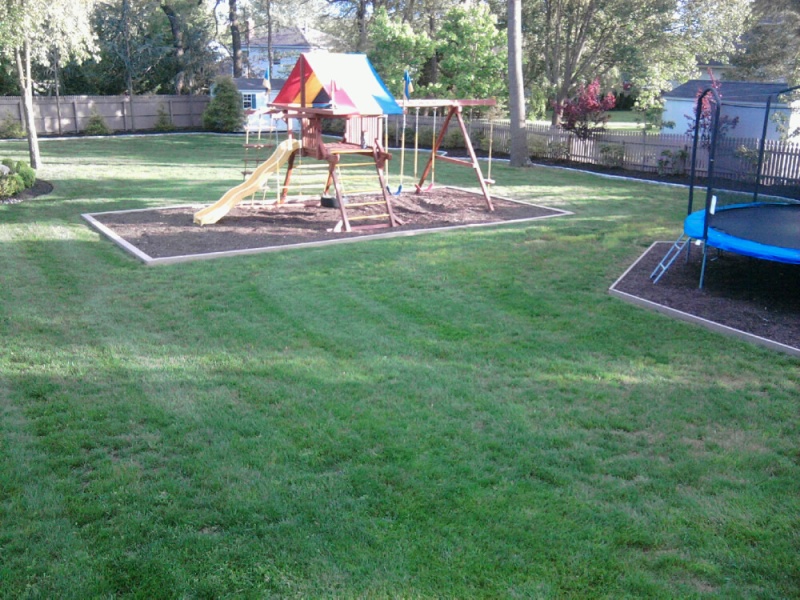
What if this Failed – Other Runoff Options?
Naturally, I was thinking about this a lot. It wasn’t until we did, truly, have three days of steady rain that I knew I was okay. But had this failed, what would I have considered next? The following:
Adding a Dry Well
A dry well would have worked for me, and I had already picked out the position if needed. This would have been much more money, and something I’m glad to say I didn’t have to take any further. I would have surely hired a local contractor (perhaps a septic system professional) to go this route – as this is another big job.
Redirecting Downspouts
I did this even though it didn’t appear to be imperative. The downspouts leading to my backyard now have underground pipes (using flexible, perforated 4-inch piping) leading the water directly to safe areas, and in one case watering a line of Leyland Cypress quite nicely.
Adding a Retaining Wall
While retaining walls may surely work for some, it was difficult to see how I might incorporate this into my backyard given my layout and elevations. Nevertheless, this is a great way to deal with surface water runoff management. Retaining walls can also make beautiful additions to any landscape design if done right – functional as well as aesthetic.
Moving back to New York and living in my Mom’s Garage
That’s right. I said it. When all else fails, run away. Fortunately, I don’t currently live in that garage. Though I surely do sometimes miss my Mom’s cooking… especially, for all you other Italian-Americans out there, her awesome pasta fagioli!
In the end, though, surface water runoff management is ultimately as straight forward as it is unforgiving: we must always be sure that water flows away from the items it can damage.

What doesn’t kill you makes you strong – well that’s what they reckon! The yard looks beautiful Mark and well worth all the effort. Our landscaping that was going to cost “about $5,000” ended up costing us $8,000! You always need that fudge factor. The cabana looks great as well, just right for sitting with a nice glass of wine on a Friday night!
After reading your Tree Planting 101 article I planted the tree that had been in its pot for many years and noticed this week it is actually starting to sprout up! I daresay it will never grow too large as the roots have been truly bonsaied over the years, but I was quite chuffed to think that it must be happy in its new home (our x-fishpond!)
I completely agree, Jan – the fudge factor is indeed a fact of life, right up there with death and taxes it seems. And I’m really glad to hear that your transplant is doing well; I suspect there’s some very fertile soil underneath that x-fishpond of yours!
I can’t believe what you went through. I definitely wouldn’t have the patience to go through what you went thorugh however, I am really glad to learn from your experience! You do have a gorgeous backyard!
You maintained a beautiful back yard even with the challenges! This is such great info and helpful for those of us who would love to have beautiful back yard like yours and without all the headaches you encountered.